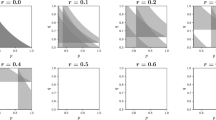Abstract
This paper proves two theorems for homogeneous juries that arise from different solutions to the problem of aggregation of dichotomous choice. In the first theorem, negative correlation increases the competence of the jury, while positive correlation has the opposite effect. An enlargement of the jury with positive correlation can be detrimental up to a certain size, beyond which it becomes beneficial. The second theorem finds a family of distributions for which correlation has no effect on a jury’s competence. The approach allows us to compute the bounds on a jury’s competence as the maximum and minimum probability of it being correct for a given individual competence and dependence structure.
Similar content being viewed by others
References
Austen-Smith D. and Banks J.S. (1996). Information aggregation, rationality and the Condorcet jury theorem. American Political Science Review 90: 34–45
Bahadur R.R. (1961). A representation of the joint distribution of responses to n dichotomous items. In: Solomon H. (eds) Studies in item analysis and prediction. Stanford University Press, Stanford, pp. 158–168
Ben-Yashar R. and Paroush J. (2000). A nonasymptotic Condorcet jury theorem. Social Choice and Welfare 17: 189–199
Berend D. and Paroush J. (1998). When is Condorcet’s jury theorem valid?. Social Choice and Welfare, 15: 481–488
Berend D. and Sapir L. (2005). Monotonicity in Condorcet jury theorem. Social Choice and Welfare 24: 83–92
Berend D. and Sapir L. (2007). Monotonicity in Condorcet’s jury theorem with dependent voters. Social Choice and Welfare 28: 507–528
Berg S. (1993). Condorcet’s jury theorem, dependency among jurors. Social Choice and Welfare 10: 87–95
Boland P.J. (1989). Majority systems and the Condorcet jury theorem. The Statistician 38: 181–189
Boland P.J., Proschan F. and Tong Y.L. (1989). Modelling dependence in simple and indirect majority systems. Journal of Applied Probability 26: 81–88
Feddersen T. and Pesendorfer W. (1997). Voting behavior and information aggregation in elections with private information. Econometrica 65: 1029–1058
Kaniovski S. (2008). The exact bias of the Banzhaf measure of power when votes are neither equiprobable nor independent. Social Choice and Welfare 31: 281–300
Kaniovski, S. (2008b). Straffin meets Condorcet. What can a voting power theorist learn from a jury theorist? Homo Oeconomicus (forthcoming).
Kaniovski Y.M. and Pflug G.C. (2007). Risk assessment for credit portfolios: A coupled Markov chain model. Journal of Banking & Finance 31: 2303–2323
Ladha K.K. (1992). The Condorcet’s jury theorem, free speech and correlated votes. American Journal of Political Science 36: 617–634
Ladha K.K. (1993). Condorcet’s jury theorem in light of de Finetti’s theorem: Majority-rule voting with correlated votes. Social Choice and Welfare 10: 69–85
Ladha K.K. (1995). Information polling through majority rule voting: Condorcet’s jury theorem with correlated votes. Journal of Economic Behavior and Organization 26: 353–372
Lazarsfeld P.F. (1956). Some observations on dichotomous systems. Sociology Department, Columbia University, New York
Levine, R. D., & Tribus, M. (Eds.) (1978). Maximum entropy formalism. The MIT Press, Cambridge
Page S.E. (2006). Path dependence. Quarterly Journal of Political Science 1: 87–115
Penrose L.S. (1946). The elementary statistics of majority voting. Journal of Royal Statistical Society 109: 53–57
Van Der Geest P.A.G. (2005). The binomial distribution with dependent Bernoulli trials. Journal of Statistical Computation and Simulation 75: 141–154
Young H.P. (1988). Condorcet’s theory of voting. American Political Science Review 82: 1231–1244
Author information
Authors and Affiliations
Corresponding author
Rights and permissions
About this article
Cite this article
Kaniovski, S. Aggregation of correlated votes and Condorcet’s Jury Theorem. Theory Decis 69, 453–468 (2010). https://doi.org/10.1007/s11238-008-9120-4
Received:
Accepted:
Published:
Issue Date:
DOI: https://doi.org/10.1007/s11238-008-9120-4




